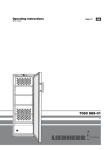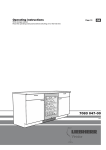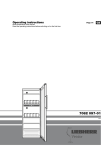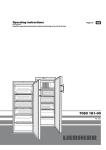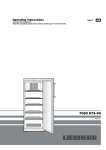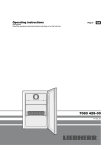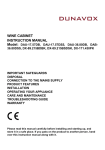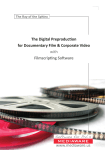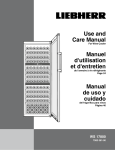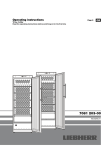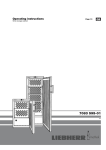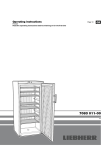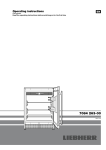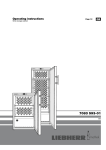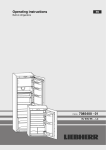Download Liebherr WTR4211
Transcript
Operating instructions Wine cooler Page 10 GB 7083 591-01 WT Disposal notes Climate rating The climate rating indicates the room temperature at which the appliance may be operated in order to achieve full refrigeration performance. The appliance contains reusable materials and should be disposed of properly - not simply with unsorted household refuse. Appliances which are no longer needed must be disposed of in a professional and appropriate way, in accordance with the current local regulations and laws. When disposing of the appliance, ensure that the refrigerant circuit is not damaged to prevent uncontrolled escape of the refrigerant it contains (data on type plate) and oil. • Disable the appliance. • Pull out the mains plug. • Cut through the connection cable. WARNING Danger of suffocation due to packing material and plastic film! Do not allow children to play with packaging material. Take the packaging material to an official collection point. The climate rating is indicated on the type plate. The position of the type plate is shown in the section entitled Description of the appliance. Climate rating SN N ST T SN-ST SN-T Room temperature +10°C to +32°C +16°C to +32°C +16°C to +38°C +16°C to +43°C +10°C to +38°C +10°C to +43°C Do not operate the appliance outside the specified room temperature range. Description of the appliance Operating and control elements Note Fit the short grid shelf in the top position only. Grid shelves Activated charcoal filter Type plate Adjustable- height feet 10 Safety instructions and warnings •To prevent injury or damage to the unit, the appliance should be unpacked and set up by two people. •In the event that the appliance is damaged on delivery, contact the supplier immediately before connecting to the mains. •To guarantee safe operation, ensure that the appliance is set up and connected as described in these operating instructions. •Disconnect the appliance from the mains if any fault occurs. Pull out the plug, switch off or remove the fuse. •When disconnecting the appliance, pull on the plug, not on the cable. •Any repairs and work on the appliance should only be carried out by the customer service department, as unauthorised work could prove highly dangerous for the user. The same applies to changing the mains power cable. •Do not allow naked flames or ignition sources to enter the appliance. When transporting and cleaning the appliance ensure that the refrigerant circuit is not damaged. In the event of damage, make sure that there are no ignition sources nearby and keep the room well ventilated. •Do not stand on the plinth, drawers or doors or use them to support anything else. •This appliance is not intended for use by persons (including children) with reduced physical, sensory or mental capabilities or lack of experience and knowledge unless they have been given initial supervision or instruction concerning use of the appliance by a person responsible for their safety. Children should be supervised to ensure that they do not play with the appliance. •Avoid prolonged skin contact with cold surfaces or chilled/frozen food.This could cause pain, numbness and frostbite. In the case of prolonged skin contact, protective measures should be taken, e.g. gloves should be worn. •Do not consume food which has been stored for too long, as it could cause food poisoning. GB •Do not store explosives or sprays using combustible propellants such as butane, propane, pentane etc. in the appliance. Electrical components might cause leaking gas to ignite.You may identify such sprays by the printed contents or a flame symbol. • Do not use electrical appliances inside the appliance. •If you have a lockable appliance, do not keep the key near the appliance or within reach of children. •The appliance is designed for use in enclosed areas. Do not operate the appliance outdoors or in areas where it is exposed to splash water or damp conditions. Range of appliance use The appliance is suitable solely for storing wine in a domestic environment or similar. This includes, for example, use -in staff kitchenettes, bed and breakfast establishments, -by guests in cottages, hotels, motels and other forms of accommodation, -in catering and similar services in the wholesale trade. Use the appliance solely as is customary within a domestic environment. All other types of use are inadmissible. The appliance is not suitable for storing and cooling medicines, blood plasma, laboratory preparations or similar substances and products covered by the 2007/47/EC Medical Devices Directive. Any misuse of the appliance may result in damage to or spoilage of stored goods. Furthermore, the appliance is not suitable for operation in potentially explosive atmospheres. Saving energy - Always ensure good ventilation. Do not cover ventilation openings or grille. - Always keep fan louvres clear. - Do not place appliance in areas of direct sunlight or next to a stove, heater or similar object. - The energy consumption depends on the installation conditions, e.g. the ambient temperature. - Keep the time the appliance is open to a minimum. Accumulated dust increases the energy consumption: - Once a year, dust the refrigerating unit together with the metal grille of the heat exchanger at the back of the appliance. 11 Setting up • Avoid positioning the appliance in direct sunlight or near cookers, radiators and similar sources of heat. Operating and control elements • The floor on which the appliance stands should be horizontal and level.Compensate for uneven floors with the adjustable feet. • Do not cover ventilation openings or grille. • Standard EN 378 specifies that the room in which you install your appliance must have a volume of 1 m3 per 8 g of R 600a refrigerant used in the appliance, so as to avoid the formation of inflammable gas/air mixtures in the room where the appliance is located in the event of a leak in the refrigerant circuit. The quantity of refrigerant used in your appliance is indicated on the type plate on the inside of the appliance. • Always install the appliance directly against the wall. Dimensions 1Upper compartment temperature display 2Lower compartment temperature display 3Upper compartment temperature setting buttons 4Lower compartment temperature setting buttons 5On/off button 6Audible warning on/off button 7Child lock activated symbol Switching the appliance on and off To switch the appliance on Press the On/Off button until the temperature display lights up. To switch the appliance off Keep the On/Off button pressed for approx. 3 seconds so that the temperature display goes out. Door open alarm If the door is left open for more than 60 seconds, the audible warning signal will sound. If the door must be opened for a lengthy period to place items into the appliance, cancel the audible warning signal by pressing the Alarm button. The alarm switches back to standby when the door is shut. Temperature alarm Electrical connection Only operate the appliance with alternating current (AC). The permissible voltage and frequency are indicated on the type plate. The position of the type plate is shown in the section entitled Description of the appliance. The socket must be properly earthed and protected by a fuse. The tripping current of the fuse must be between 10 A and 16 A. The socket must not be situated behind the appliance and must be easily accessible. Do not connect the appliance using an extension cable or extension socket. Do not use stand-alone inverters (conversion of direct current to alternating current/threephase current) or energy-saving plugs. Risk of damage to the electronic control system! If the temperatures in the interior are out of the permitted range, the audible warning signal will sound and the temperature display will flash. After a lengthy power failure, the temperature in the interior may have risen to too high a level. After the power supply returns, the fall in temperature can be watched on the display. • Cancel the audible warning signal by pressing the Alarm button. The temperature display will stop flashing as soon as the temperature in the interior has reached the set value. Temperature alarm after a fault in the appliance If the appliance develops a fault, the temperature in the interior may rise too high or fall too low. The audible warning signal will sound and the temperature display will flash. If the temperature displayed is too high (warm), first check whether the door is closed correctly. If the temperature display continues to show a value that is too high or too low after one hour, contact the customer service department. • Cancel the audible warning signal by pressing the Alarm button. If F1 or F3 appears in the display, the appliance has suffered a fault. In this case, contact the customer service department. 12 Multi-temperature wine cooling Insert the grid shelves into the appliance as shown in the illustration. Insert the short grid shelf with a depth of 450 mm in the topmost position (see section entitled Description of the appliance). With this multi-temperature wine cabinet, you can cool wines to the perfect temperature for drinking. Additional functions GB In set-up mode you can set the child lock and adjust the brightness of the display. The child lock is designed to protect the appliance from being switched off accidentally. Activating the child lock Press for 5 seconds. Display = The lowest compartment has the lowest temperature. The temperature rises steadily up to the top compartment. Display = Store the different types of wine in the various compartments. Display = Red wines Display = Rosé wines White wines Sparkling wines, Prosecco Display = Champagne Setting the temperature You can change the temperature in the top compartment using the Up/Down buttons on the left and the temperature in the bottom compartment using the Up/Down buttons on the right. Increasing the temperature Press the Up button. Reducing the temperature Press the Down button. - When pressing one of the buttons for the first time, the display will start to flash. - Pressing this button again enables you to change the temperature setting. - The electronic controls will switch over automatically about 5 seconds after the last time you pressed the button, and the actual temperature will be displayed. Deactivating the child lock Press for 5 seconds. Display = Display = Display = Display = Display = Setting range for top compartment +16°C to +18°C. Setting range for bottom compartment +5°C to +7°C. The temperature setting relates to the centre of the relevant compartment. If the temperature in the top compartment is changed, the temperature progression in the upper section of the interior will change. If the temperature in the bottom compartment is changed, the temperature progression in the lower section of the interior will change. Note If the Light button is pressed so that the interior light is permanently lit, the temperature in the top section will rise slightly. 13 Additional functions Humidifier Adjusting the display brightness Press for 5 seconds. Display = The right humidity is vitally important for the proper storage of wine. A special humidifier increases the humidity in the interior. Display = Display = Use buttons and to select the desired setting. h1 = minimum brightness h5 = maximum brightness Display = Spread out the supplied lava stones in the appliance's defrost drain gully. As you insert the stones, ensure that you do not block the drain tube. Display = The adjusted brightness will be activated after one minute. Then fill the defrost drain gully to the top of the drain tube with water. Note If a button is pressed, the display lights up for one minute at maximum brightness. In normal operation, the lava stones are kept moist by the defrost water in the appliance. When commissioning the appliance, the adjusted brightness will only be active once the set interior temperature of the appliance has been reached. If the humidity at the place of installation is high, you may expect that the humidity in the appliance will be raised. This may result in the labels peeling. Depending on the type of label adhesive, this may result in slight mould formation. This can be rectified by carefully cleaning any adhesive residues off the bottles. Demo mode Demo mode can be activated for presenting the appliance at exhibitions or in salesrooms as though in normal operating mode. When in this mode, the cooling circuit is switched off! If this mode is activated by accident, it can be deactivated as detailed below. + Press for 5 seconds. Display = Display = The refrigeration unit switches on. The temperature display flashes. The appliance is now in normal operating mode.. 14 Labels The appliance is supplied with a label holder with labels for each shelf. Use these to label the type of wine stored on each shelf. Storage diagrams for 750 ml Bordeaux bottles GB Additional labels can be obtained from your dealer. The storage capacity stated is only possible with the grid shelves in this configuration. Click the label holder into place and slide the label in from the side. Air exchange with activated charcoal filter The way in which wines continue to mature depends on the ambient conditions. The quality of the air is therefore decisive for preserving the wine. We recommend that you replace the filter once a year. Filters can be obtained from your dealer. Changing the filter: Take the filter by the handle. Turn it 90° to the left or right and remove. Inserting the filter: Insert with the handle in a vertical position. Turn it 90° to the left or right until it clicks into place. Important The maximum load per grid shelf is 60 kg. Number of bottles 32 33 33 33 33 36 Total 200 bottles 15 Cleaning Before cleaning always switch off the appliance. Pull out the mains plug or remove/unscrew the fuse. • Clean the inside and outer walls with lukewarm water and a little detergent. Do not use abrasive or acid cleaners or chemical solvents. Changing over door hinges Door hinges should only be changed by a trained expert. Changing the door hinges must be done by two people. • Use a glass cleaner to clean the glass surfaces and a commercially available stainless-steel cleaning agent for the stainless-steel surfaces. Do not use steam cleaners because of the risk of injury and damage. • Ensure that no cleaning water penetrates into the electrical components or ventilation grille. 1.Remove screw from lower hinge bracket. • Do not damage or remove the type plate on the inside of the appliance. It is very important for servicing purposes. 1 Malfunctions • F1 or F3 appears in the display. –The appliance has suffered a fault. Contact the customer service department. You may be able to rectify the following faults by checking the possible causes yourself. • Appliance does not function –Is the appliance switched on? –Is the plug correctly fitted in the mains socket? –Is the socket fuse intact? • When inserting the mains plug, the refrigeration unit does not switch on, but a value is shown in the temperature display. –Demo mode is activated. Deactivate demo mode as described in the section entitled Additional functions - Demo mode. • Loud running noise –Is the appliance set up firmly on the floor? –Does the appliance cause nearby items of furniture or objects to vibrate? Ensure that the appliance is stable and that all parts at the back can vibrate freely.Please note that noises caused by the refrigerant circuit cannot be avoided. • The temperature is not low enough –Is the temperature setting correct (see „Setting the temperature“)? – Does the separately installed thermometer show the correct reading? – Is the ventilation system working properly? – Is the appliance set up too close to a heat source? If none of the above causes apply and you cannot rectify the fault yourself, contact the nearest customer service department stating the type of appliance 1, service number 2and appliance number 3as indicated on the type plate. 2.Open the door approx. 45° and lift upwards. Important As a result of its heavy weight, the door must be raised and removed by one person while the other executes the intermediate steps. 3.Push the pin upwards using your fingertip. 4 2 4.Pull the door to the front and remove it downwards. 3 5 5. Transfer plug. 6. Transfer door handle and plugs to the other side. 6 The position of the type plate is shown in the section entitled Description of the appliance. 9 8 7.Unscrew the pin. Use the spanner provided. 8.Transfer the covers to the opposite side. 9.Screw in the pin on the opposite side. 16 7 GB 10 16. Screw the screw into the pin again and tighten. 16 11 12 10. Unscrew hinge bracket. 11. Remote the cover, turn it through 180° and re-fit it on the opposite side. 12. Screw hinge bracket into place. Adjusting the lateral tilt of the door If the door is at an angle, adjust the angle. 13 17 17. Remove middle screw from hinge bracket. 13. Insert the pin into the left-hand door mounting. Use your index finger to hold the pin while you are assembling the door. As a result of its heavy weight, the door must be held secure by one person. This screw is no longer needed. 18. Undo screws and slide hinge bracket to the right or left. 14. Locate the door on the upper pin as shown in the illustration and guide it to the lower hinge bracket. Important Tighten screws. 14 18 15. Lift the door upwards and turn the pin until it fits into the bore hole of the hinge bracket. Slowly lower the door downwards. The lower part of the pin must be fully engaged in the bore hole of the hinge bracket. 15 Shutting your appliance down If your appliance is to be shut down for any length of time, switch it off and disconnect the plug or switch off or unscrew the fuse. Clean the appliance and leave the door open in order to prevent unpleasant smells. The appliance complies with the relevant safety regulations and EC Directives 2004/108/EC and 2006/95/EC. 17









